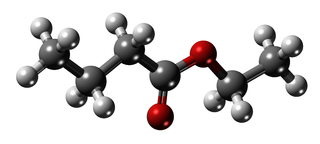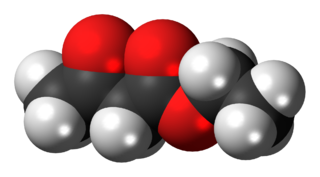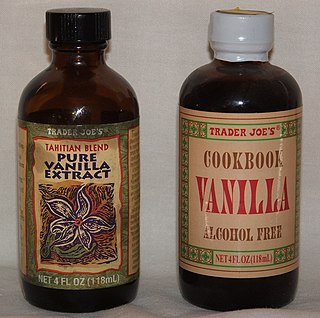
In chemistry, an ester is a chemical compound derived from an acid in which at least one –OH (hydroxyl) group is replaced by an –O–alkyl (alkoxy) group. Usually, esters are derived from a carboxylic acid and an alcohol. Glycerides, which are fatty acid esters of glycerol, are important esters in biology, being one of the main classes of lipids, and making up the bulk of animal fats and vegetable oils. Esters with low molecular weight are commonly used as fragrances and found in essential oils and pheromones. Phosphoesters form the backbone of DNA molecules. Nitrate esters, such as nitroglycerin, are known for their explosive properties, while polyesters are important plastics, with monomers linked by ester moieties. Esters usually have a sweet smell and are considered high-quality solvents for a broad array of plastics, plasticizers, resins, and lacquers. They are also one of the largest classes of synthetic lubricants on the commercial market.

Ethyl butyrate, also known as ethyl butanoate, or butyric ether, is an ester with the chemical formula C6H12O2. It is soluble in propylene glycol, paraffin oil, and kerosene. It has a fruity odor, similar to pineapple and is a key ingredient used as a flavor enhancer in processed orange juices. It also occurs naturally in many fruits, albeit at lower concentrations.

Cinnamic acid is an organic compound with the formula C6H5CH=CHCOOH. It is a white crystalline compound that is slightly soluble in water, and freely soluble in many organic solvents. Classified as an unsaturated carboxylic acid, it occurs naturally in a number of plants. It exists as both a cis and a trans isomer, although the latter is more common.

Ethyl acetate is the organic compound with the formula CH
3−COO−CH
2−CH
3, simplified to C
4H
8O
2. This colorless liquid has a characteristic sweet smell and is used in glues, nail polish removers, and in the decaffeination process of tea and coffee. Ethyl acetate is the ester of ethanol and acetic acid; it is manufactured on a large scale for use as a solvent.

Valeric acid, or pentanoic acid, is a straight-chain alkyl carboxylic acid with the chemical formula CH
3(CH
2)
3COOH. Like other low-molecular-weight carboxylic acids, it has an unpleasant odor. It is found in the perennial flowering plant valerian, from which it gets its name. Its primary use is in the synthesis of its esters. Salts and esters of valeric acid are known as valerates or pentanoates. Volatile esters of valeric acid tend to have pleasant odors and are used in perfumes and cosmetics. Ethyl valerate and pentyl valerate are used as food additives because of their fruity flavors.

Formate (IUPAC name: methanoate) is the anion derived from formic acid. Its formula is represented in various equivalent ways: HCOO− or CHOO− or HCO2−. It is the product of deprotonation of formic acid. It is the simplest carboxylate anion. A formate (compound) is a salt or ester of formic acid.
Sodium ethoxide is the organic compound with the formula C2H5ONa. It is a white solid, although impure samples appear yellow or brown. It dissolves in polar solvents such as ethanol. It is commonly used as a strong base.

The organic compound ethyl acetoacetate (EAA) is the ethyl ester of acetoacetic acid. It is mainly used as a chemical intermediate in the production of a wide variety of compounds, such as amino acids, analgesics, antibiotics, antimalarial agents, antipyrine and aminopyrine, and vitamin B1; as well as the manufacture of dyes, inks, lacquers, perfumes, plastics, and yellow paint pigments. Alone, it is used as a flavoring for food.

Ethyl bromoacetate is the chemical compound with the formula CH2BrCO2C2H5. It is the ethyl ester of bromoacetic acid and is prepared in two steps from acetic acid. It is a lachrymator and has a fruity, pungent odor. It is also a highly toxic alkylating agent and may be fatal if inhaled.
Ethyl heptanoate is the ester resulting from the condensation of heptanoic acid and ethanol. It is used in the flavor industry because of its odor that is similar to grape.
Heptanoic acid, also called enanthic acid, is an organic compound composed of a seven-carbon chain terminating in a carboxylic acid. It is an oily liquid with an unpleasant, rancid odor. It contributes to the odor of some rancid oils. It is slightly soluble in water, but very soluble in ethanol and ether.

An extract is a substance made by extracting a part of a raw material, often by using a solvent such as ethanol or water. Extracts may be sold as tinctures, absolutes or in powder form.

Ethyl benzoate, C9H10O2, is the ester formed by the condensation of benzoic acid and ethanol. It is a colorless liquid that is almost insoluble in water, but miscible with most organic solvents.

Ethyl methylphenylglycidate, commonly known as strawberry aldehyde, is an organic compound used in the flavor industry in artificial fruit flavors, in particular strawberry.

Ethyl acrylate is an organic compound with the formula CH2CHCO2CH2CH3. It is the ethyl ester of acrylic acid. It is a colourless liquid with a characteristic acrid odor. It is mainly produced for paints, textiles, and non-woven fibers. It is also a reagent in the synthesis of various pharmaceutical intermediates.

Ethyl chloroformate is the ethyl ester of chloroformic acid. It is a reagent used in organic synthesis for the introduction of the ethyl carbamate protecting group and for the formation of carboxylic anhydrides.

l-Arginine ethyl ester or ethyl arginate is an alternative supplement form of the conditionally-essential amino acid arginine bound to an ethyl ester. Esters are organic compounds formed by esterification – the reaction of carboxylic acid and alcohols.
Propyl hexanoate (C9H18O2), also known as propyl caproate, is an ester formed by the reaction of propanol with hexanoic acid. Although it is a completely different ester, propyl hexanoate shares the same chemical formula with methyl octanoate, ethyl heptanoate, butyl pentanoate, etc. because they all have the same total carbon chain length. The scent of this ester can be described as that of blackberries, pineapple, cheese or wine.
Ethyl decadienoate, also known as pear ester, is an organic chemical compound used in flavors and perfumery for its pear-like taste and odor.

Ethyl isovalerate is an organic compound that is the ester formed from ethyl alcohol and isovaleric acid. It has a fruity odor and flavor and is used in perfumery and as a food additive.
















